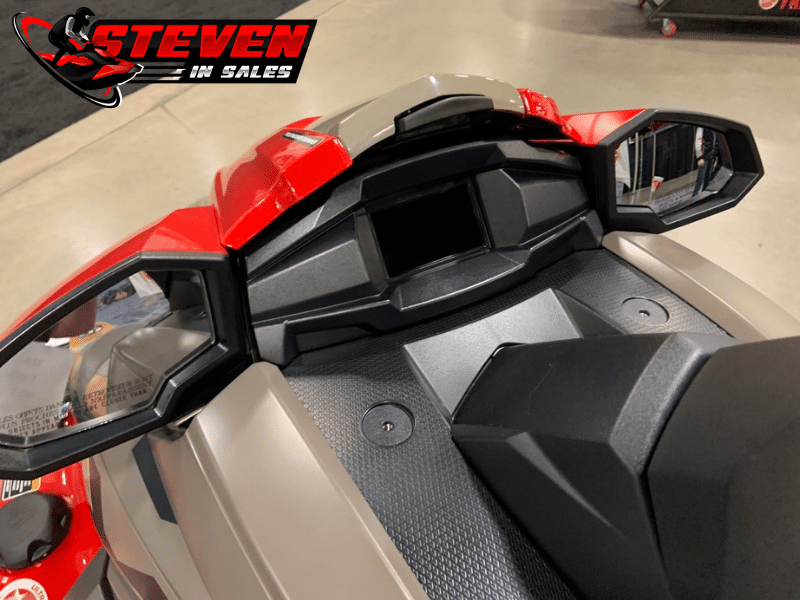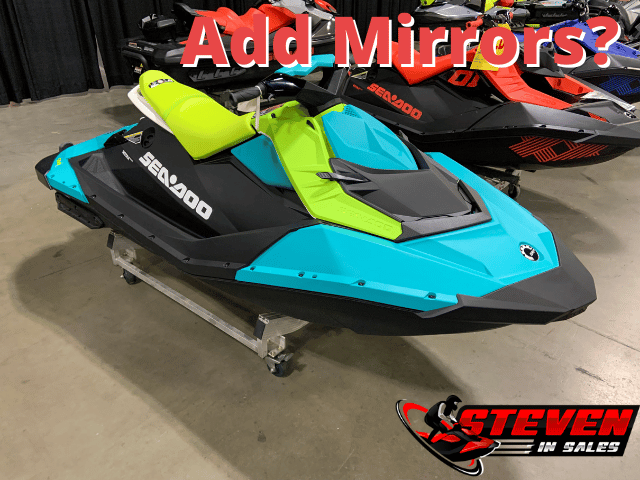In the wonderful world of PWC tow sports, where riders are propelled across the water’s surface at breathtaking speeds, every split-second decision matters.
Yet, amidst the adrenaline rush, there’s a crucial yet often overlooked component that ensures safety and precision: mirrors.
These unassuming accessories serve as the eyes at the back of the rider’s head, providing invaluable insights and enhancing the overall experience. Let’s dive into why mirrors are not just optional add-ons, but essential tools for mastering the waves and maximizing the thrill of tow sports.
Are Mirrors Standard On All PWCs?
Many people don’t realize this, but mirrors are not always standard on PWCs. Most models use them, but not every model.
Mirrors are required if you intend to tow anyone on a tube, wakeboard or skis. Some states and countries only require them if you don’t use a “spotter”(explained below), while others require both.
If you never intend to tow someone or any tow-sports, mirrors are not legally required. I honestly don’t think they’re worth it! As the mirrors you get today are difficult to see out of and often can’t be adjusted. I rather turn my head or rely on my spotter.
To see if your state requires mirrors and/or spotter, check out this US Coast Guard Chart here.
Spotter Explained
A spotter is another person that rides backwards on the PWC to watch the person being towed.
If your watercraft does not use mirrors or your state requires them and a spotter, you will need someone to ride backwards to watch the person(s) being towed.
“The job of the spotter is to alert the driver if the person being towed falls off and help locate them.“
If you like doing tow sports, then Sea-Doo has ski-pylon and accessories that make tow-sports fun and easy. Sea-Doo even has two models made for towing called the WAKE and WAKE Pro.
Adjustability
I’m blown away by how many new, current year model, jet skis you can’t adjust the side-view mirrors. Yes, they’re fixed and it drives me nuts. They’re basically there to “appease local laws” and not be to be useful.
The manufacturers are now leaning more towards fixed wide-angle mirrors, as it’s more useful than adjustable ones. Though, I like how Kawasaki has rearview cameras, which is helpful for pull sports!
Mirrors & Seating Capacity
Your jet ski mirrors and your seating capacity can affect each other.
- 3-Seater Jet Ski with Mirrors:
- Can tow 2 people if allowed by the state.
- 2-Seater Jet Ski with Mirrors:
- Can tow 1 person if allowed by the state.
- If the State Requires Mirrors and a Spotter:
- A 3-seater jet ski can only tow 1 person.
- A 2-seater jet ski cannot be used for towing.
Capacity
The total people on the craft and the total people being towed can’t exceed the seating capacity.
And depending on the state will determine whether a spotter is required or not, even if you got mirrors. In some states, having mirrors “count as a spotter”, so be sure to know your state’s laws on spotters!
This rule is in place in case someone gets hurt, so there is plenty of room for everyone to get back to safety. Water patrol is very strict about this one and will give tickets if you don't follow the local laws.
Outside USA
Other countries and states are not as strict about this seating capacity and towing rule, but it is a good suggestion to follow.
Adding Mirrors
If you don’t get mirrors on your machine, you can always add them, with most offering mirror kits (Amazon Link Ad) you can install.
One example is the Sea-Doo Spark, it does not come with mirrors, but you can add mirrors. I don’t find them difficult to add either, but many don’t like it as sometimes you need to drill holes in your machine.
Before Sea-Doo came out with the mirror kit for the Spark, people were adding bike mirrors. While it works, it’s not ideal and looks funny. Bike mirrors are usually smaller than the mirrors put on watercraft and not only look funny but don’t work as well!
Models Without Them
It’s more common for low-end models to not use mirrors.
The Sea-Doo Spark and Yamaha EX but also rental models will often not come with mirrors. (One thing less to break and save money on manufacturing)
Besides these few models, most other jet skis will come with some type of mirror. Whether it’s adjustable is up in the air, as many manufacturers are moving away from adjustable to fixed wide-angle.
Skier Down Flag For Tow Sports
A Skier Down Flag is needed in many states that allow pull sports. It’s used when the person you’re pulling falls off to alert the other boats.
You can get Skier Down Flags here (Amazon Link Ad).
It’s important you understand your local laws when towing someone.
If your state doesn’t require a Skier Down Flag, it’s still a good idea to use one. Even if someone doesn’t know what it means, it gets their attention, and they slow down.
What To Keep In Mind for Tow Sports!
Engaging in tow sports on a jet ski requires more than just the watercraft itself. Proper tow sports equipment is essential for ensuring safety and maximizing enjoyment on the water. Here are some key pieces of equipment riders should consider:
- Tow Rope: High-quality tow rope made for tow sports are important for safely pulling riders on wakeboards, water skis, or tubes. These ropes are typically made of strong materials such as nylon and use handles for the person being pulled to hold on to. Don’t cheap out on these ropes, as they can snap and hit the person(s) being pulled!
- Wakeboards and Water Skis: Choosing the right wakeboard or water skis is crucial if you want to perform tricks, jumps, and maneuvers with ease. You should select equipment that suits their skill level, riding style, and preferences, ensuring a comfortable and enjoyable experience on the water. Don’t forget where you’ll place these things, the Sea-Doo WAKE models use wakeboard racks.
- Tubes: Towable tubes provide hours of fun for riders of all ages, but it’s important to choose models that are safe and suitable for towing behind a jet ski. Since there is a seating capacity and rules vary state to state, make sure you’re not buying a tube that is too big. Stick to the one-person tubes if you’re not sure.
- Safety Gear: In addition to tow sports equipment, riders should also get safety gear such as goggles, life jackets, and wetsuits. These items help protect against impact injuries, flotation in case of falls, and provide thermal insulation in colder water conditions. Every state requires life jackets for a good reason, but I suggest goggles, as getting water in your eyes is annoying.
Rear-Facing Camera?
Kawasaki got a model with a review camera for watching the people behind you. It’s a great idea, and I’m sure other manufacturers will copy.
Besides water splashing on the camera, this is the best option if you want to keep an eye on the people you tow. With watercraft getting full color screens and getting bigger every year, I can see this slowly becoming a standard, at least on higher-end models.
This camera is not great for reversing, you’re better off turning your head. But if you driving forward, it’s best to keep looking forward, so having a display right below your sight to keep an eye on the people pulled on the tube is huge!


